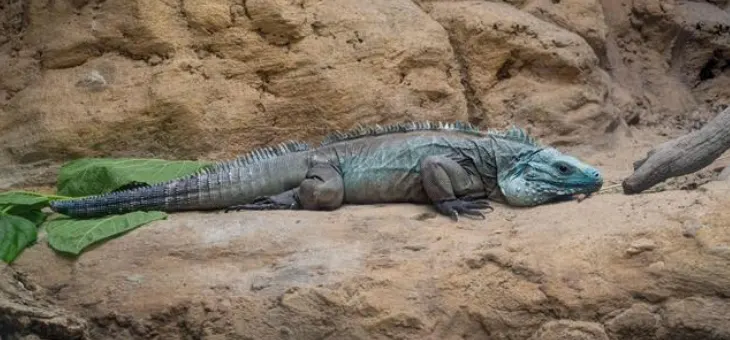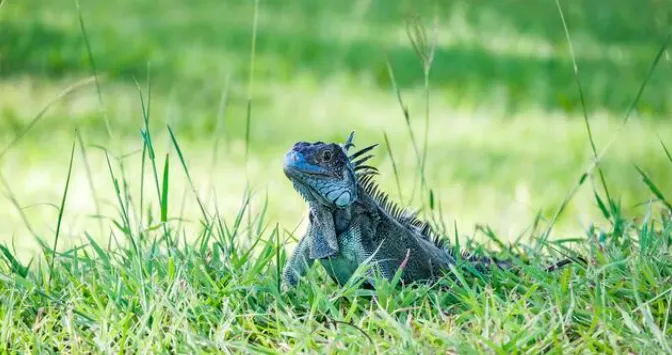The Blue Iguana, scientifically known as Cyclura lewisi, is a captivating species native to the Grand Cayman Island. Despite its striking appearance and fascinating behaviors, this unique reptile is currently listed as endangered, with only a few hundred individuals remaining in the wild. This blog post will explore the Blue Iguana’s characteristics, behavior, habitat, and the conservation efforts dedicated to preserving this remarkable creature.

Table of Contents
Appearance and Physical Characteristics
The Blue Iguana is easily recognized by its distinctive coloration, which ranges from dusky blue to gray, with barely visible crossbands along its body. Mature males typically display a more vibrant turquoise blue, especially during the mating season, while females are often olive green to pale blue. Younger iguanas are usually darker, featuring a dark brown or green hue with uniform banding.
Males are generally larger than females, with more prominent dorsal crests and larger femoral pores on their thighs, which release pheromones. Adult Blue Iguanas can grow up to 30 inches in length and weigh around 30 pounds, although axanthic individuals, which lack blue and yellow pigmentation, are smaller, measuring only 10 to 14 inches.
Behavior and Lifestyle
Blue Iguanas are primarily solitary animals, coming together only during the breeding season. They are diurnal, meaning they are active during the day and prefer to sleep at night in tree cavities or rock holes. Although primarily terrestrial, these iguanas can climb trees up to 15 feet high, with younger individuals being more arboreal.
These reptiles are known for their aggressive territorial behavior, even at a young age. Males maintain larger territories and may have multiple sleeping spots, while females tend to defend smaller areas, particularly around their feeding and basking sites. In captivity, Blue Iguanas can be aggressive toward each other, especially in confined spaces.
Habitat and Diet
Blue Iguanas are indigenous to the dry, rocky forests of the Grand Cayman Island. They thrive in coastal areas with cacti and other thorny plants but can also adapt to semi-deciduous forests, scrub woodlands, and man-made habitats. These reptiles prefer sleeping in tree cavities and rock holes, which provide shelter from predators and extreme weather conditions.
As herbivores, Blue Iguanas primarily feed on stems, leaves, fruits, and flowers. However, they have been observed consuming fungi, soil, and even insects on rare occasions. In captivity, their diet is often supplemented with carrots, sweet potatoes, leafy greens, and herbivorous pellets.
Reproduction and Life Cycle
The breeding season for Blue Iguanas typically occurs between May and June. Males court females with a series of head bobs before circling them and grasping the nape of their necks. After mating, females dig nests in sun-exposed earth pockets to lay their eggs, with clutch sizes ranging from 1 to 21 eggs.
The incubation period lasts 65 to 90 days, during which the nest temperature remains around 32 degrees Celsius. Blue Iguanas reach sexual maturity at around four years old in captivity. While their natural lifespan is estimated to be 25 to 40 years, some individuals in captivity have lived up to 69 years.
Conservation Status and Threats
Despite their resilience, Blue Iguanas face numerous threats, including predation by feral animals, such as dogs and cats, and habitat destruction due to deforestation, industrialization, and urbanization. The species was once on the brink of extinction, with fewer than 15 individuals remaining in the wild by 2003. However, thanks to intensive conservation efforts, the population has slowly begun to recover, with an estimated 443 mature individuals currently existing.

Q&A Section
Q1: Are Blue Iguanas good pets?
- A: Yes, Blue Iguanas can make good pets, but they require a significant amount of attention and care. They are one of the most popular pet lizards, but prospective owners should be prepared for a long-term commitment, as these iguanas can live for several decades.
Q2: What do Blue Iguanas eat?
- A: Blue Iguanas are primarily herbivores, feeding on stems, leaves, fruits, and flowers. In captivity, their diet can include leafy greens, vegetables, and herbivorous pellets, with occasional protein sources like insects or small animals.
Q3: How big do Blue Iguanas get?
- A: Adult Blue Iguanas can grow up to 30 inches in length and weigh around 30 pounds. However, axanthic blue iguanas are smaller, reaching only 10 to 14 inches.
Q4: Why are Blue Iguanas endangered?
- A: Blue Iguanas face threats from habitat loss due to deforestation and urbanization, as well as predation from feral animals like dogs and cats. Conservation efforts are helping to increase their population, but they remain endangered.
Q5: What is the difference between Blue Iguanas and Green Iguanas?
- A: The main difference is size and color. Blue Iguanas are larger and heavier than Green Iguanas and have a distinctive dusky blue to grey coloration, compared to the bright green of their counterparts.
The Blue Iguana is a fascinating species that continues to captivate scientists and reptile enthusiasts alike. Through ongoing conservation efforts, there is hope that these remarkable lizards will continue to thrive in their natural habitat.
- Enchi Ball Python: A Unique and Stunning Morph of Python regius - March 27, 2025
- Emerald Tree Monitor: The Enigmatic Green Guardian of the Rainforest - March 26, 2025
- The Egyptian Cobra (Naja haje): A Fascinating Serpent - March 25, 2025
